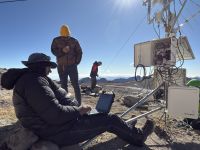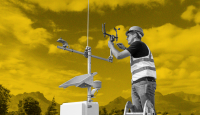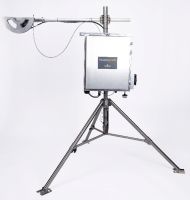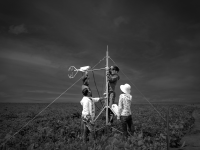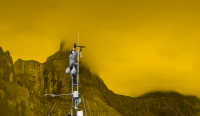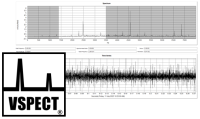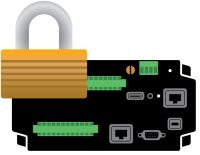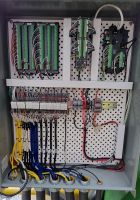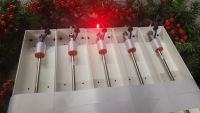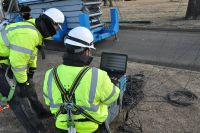Campbell Scientific ブログ 役立つハウツー情報と専門家のアドバイス
Displaying 1 - 20 of 186 articles
地域ごとの洞察から世界基準まで:自分に合った気象観測所の選び方
著者: Jamie McDonald | 最終更新日: 12/01/2025 | コメント: 0
気象や環境観測においては、単一の気象観測所の規模ではあらゆるシナリオに対応できません。単一の研究拠点を運営する場合でも、地域ネットワークに拡大する場合でも、あるいは全国規模の気象観測ネットワークを管理する場合でも、適切なタイプの気象観測所を選択することが大きな違いを生みます。 Campbell Scientificでは、コンパクトなIoT(モノのインターネット)ステーションから、世界気象機関(WMO)の各国気象サービスガイドラインに準拠した本格的なステーションまで、幅広いレベルのシステムを設計しています。しかし、どのレベルがお客様にとって最適なのか、どのように判断すればよいのでしょうか?この記事では、Campbell Scientificの自動気象ステーション(AWS)の3つの主要なレベルについて解説し、お客様の測定ニーズに最適なソリューションを見つけるお手伝いをいたします。 IoTベース スケーラブル 大規模展開に適した研究グレード プロジェクトに適したステーションのサイズを見つける モニタリングのニーズはそれぞれ異なります。プロジェクトによっては、小型観測所を用いて少数の地点で迅速かつ低コストで洞察を得ることが求められる一方、国または世界規模の観測ネットワークに供給するために、継続的な研究レベルのデータが必要となる場合もあります。 適切なシステムを選択するには、いくつかの重要な要素を考慮する必要があります。 測定の忠実度:観察にはどの程度の精度と信頼性が必要ですか? スケーラビリティ:これはスタンドアロン ステーションですか、それとも成長中のネットワークの一部ですか? 基準とコンプライアンス:データは科学的研究や運用予測および早期警告に使用されますか? 接続性:どのような通信方法が利用可能ですか? 携帯電話、衛星、イーサネット、あるいはその他でしょうか? コストと生涯価値:ハードウェアだけでなく、メンテナンス、キャリブレーション、データ管理にかかる予算はいくらですか? これらの質問を念頭に置いて、さまざまな目的のための Campbell Scientific 気象ステーションの 3 つの例を詳しく見てみましょう。 Tier 1: IoTベースの気象ステーション|スマート、シンプル、そして俊敏 複雑な設定なしで信頼性の高いデータが必要な場合は、IoT対応の気象ステーションが賢明な出発点です。これらのコンパクトで費用対効果の高いシステムは、Campbell Scientificの堅牢なセンサーと、シンプルなプラグアンドプレイのストレージおよび接続性を備えており、正確なローカルデータをCampbellCloud™ダッシュボードに直接提供します。 シングルセンサー向け Aspen™10 IoT エッジデバイス はコンパクトで導入も簡単です。ソーラーパネルを内蔵しているため、別途電源を用意する必要がなく、10分以内にセットアップしてCampbellCloudに接続できます。コーディングは不要です。 ClimaVue™50 G2 などの互換性のあるSDI-12気象センサーを接続するだけで、IoTに関するWikipediaのページを読むよりも短い時間で、あらゆる気象データを簡単に入手できます。 シングルセンサー向け Aspen 10 IoT エッジデバイス おすすめ: Aspen 10 とそのセンサーの組み合わせについて詳しくご覧ください。 これらのステーションは次のような場合に最適です。 既存のネットワークの空白を埋める スマートシティ 大規模な気象観測所には適さない場所からの超ローカル気象データ 教育または研究プロジェクト パイロット監視サイトまたは短期展開 なぜ機能するのか: 手頃な価格で迅速に導入可能:インストールが簡単なので、数分以内にデータの収集を開始できます。 クラウド対応:統合された通信プロトコルにより、CampbellCloud に直接接続してデータの視覚化と操作が可能になります。 低価格:技術的な知識は必要なく、低価格でコンパクトかつ強力なパッケージである IoT ステーションは、データが最も必要な場所に迅速に導入するのに最適です。 考慮すべき事項: これらのステーションには、本格的な AWS またはメソネット システムと比較すると、センサー スイートが限られています。 タワーの高さが低いと、風関連の測定に影響する可能性があります。 これらのステーションは、WMO または全球基本観測ネットワーク (GBON) に準拠することを目的としたものではありません。 ベースライン気象データを収集したり、微気候を監視したり、スケールアップする前に新しいサイトを検証したりする場合は、これが適切な層になる可能性があります。 Tier... 続きを読むPakBus® 暗号化 でデータを安全に保つ方法:パート2
著者: Shaurya Rastogi | 最終更新日: 11/17/2025 | コメント: 0
このシリーズの2回目のブログ記事では、自動監視プラットフォームのセキュリティを維持するための実践的な追加手順をご紹介します。PakBus暗号化に関する最初の記事をまだ読んでいない方、またはもう一度読み返したい方は、 PakBus® 暗号化でデータを安全に保つ方法:パート1をご覧ください。 I'll be covering a lot of information in this blog article. Here's a linked list of the topics if you want to move back and forth between them a little more easily: Secure Your Programs and Connections Lock Down the Terminal Menu Control Telnet Access How... 続きを読む自動気象ステーション(AWS)の初心者向けガイド
著者: Aspen Nielsen | 最終更新日: 11/10/2025 | コメント: 2
気象が意思決定、安全、生活、そして研究に影響を与えるとき、推測の余地はありません。現代社会は、正確な気象情報を含むデータに依存しています。「データに基づく意思決定」はしばしば流行語のように扱われますが、現場では、不確実な状況下での対応と、自信を持って準備を整えることの違いを意味します。 ここで、自動気象ステーション (AWS) の出番です。これらの堅牢なシステムは、厳しい環境でも継続的かつほぼ独立して動作するように構築されており、常時監視を必要とせずに正確な気象データを収集します。 この記事では、AWSを構成するコンポーネントとその重要性、そしてデータロガーからセンサー、ソフトウェアに至るまで、主要な計測機能について解説します。まだ検討段階の方でも、導入の準備が整った方でも、このガイドは気象測定を効果的に活用するための出発点となるでしょう。 自動気象観測所とは何ですか? AWSは、土壌、表層水、大気データなどの環境条件を、人的介入を最小限に抑えながら、高精度で継続的に監視・記録するように設計されたシステムです。多様なセンサーを搭載したAWSは、農業、道路気象、環境研究、悪天候監視、航空など、様々な用途において、情報に基づいた意思決定を支援する正確なリアルタイムデータを提供します。 AWS ソリューションは、データの収集と転送の両方を自動化することで、信頼性の高い 24 時間体制の洞察を提供し、ユーザーが変化する状況に積極的に対応できるようにします。 ほとんどの AWS セットアップには、次のようないくつかの主要コンポーネントが含まれています。 センサー– 気温やフラックスから降水量や視程まで、Campbell Scientific は、環境、インフラストラクチャ、再生可能エネルギーのアプリケーション向けに、堅牢で信頼性の高いさまざまなセンサーを提供しています。 データロガー– データロガーはAWS全体の頭脳であり、センサーからの測定値を収集する役割を担います。一部のデータロガーには、セルラー、Wi-Fi、イーサネット接続などの通信オプションが組み込まれています。 電源– 気象ステーションを継続的に稼働させるには、電源が不可欠です。電力要件は、センサーの選択、AWSの設置場所、その他の要因によって大きく異なります。必要な電力が不明な場合は、営業エンジニアにご相談ください。電力予算についてご説明いたします。 計測機器を過大な電力から保護するには、様々な方法があります。サージ保護、避雷器、充電レギュレータ、あるいはこれら3つを組み合わせた方法など、いずれの場合でも、計測機器を保護するための積極的なアプローチが一般的に推奨されます。 ソリューションによっては、ソーラーパネルとバッテリーの組み合わせが必要な場合もあれば、有線電源が必要な場合もあります。お客様の測定ニーズに合わせて最適なソリューションをご提案できるよう、セールスエンジニアがお手伝いいたします。 通信/テレメトリ機器– データロガーからデータを手動で収集する場合でも、携帯電話、イーサネット、無線、Wi-Fi、衛星経由で通信する場合でも、データの受信方法を考慮することは AWS 設計の重要な要素です。 取り付け機器と筐体– 適切な三脚、タワー、クロスアーム、筐体を選択することで、計測機器の安定性と保護を確保できます。正しい取り付け手順も、正確な測定を保証する上で非常に重要です。 ソフトウェア– データロガーのプログラミング、データ管理、可視化にはソフトウェアを使用し、実用的な洞察を提供します。CampbellCloud™からLoggerNet、さらにはアプリケーション固有のソフトウェアオプションまで、Campbell Scientificは豊富なソフトウェアオプションをご用意しており、お客様のニーズに合わせた最適なソリューションを提供します。 主要な測定項目とその重要性 特定のニーズに応じて監視ステーションにさまざまなタイプのセンサーを追加できますが、このセクションでは、環境監視で最もよく使用されるセンサーのいくつかに焦点を当てます。 気温センサー– AWSの中核コンポーネントとみなされることが多い気温センサーは、正確な気温測定によって他の多くのセンサーの測定値をサポートします。Campbell Scientificのすべての気温センサーには、互換性のある日射シールドの使用が推奨されます。おすすめ: 世界気象機関(WMO)の温度仕様を満たす必要がありますか?WMOガイドラインが重要な理由と、それを達成、あるいはさらに上回る方法についての詳細なガイドについては、「0.1℃の挑戦:WMOの推奨事項を満たす温度センサーの熱」をご覧ください。 気温・相対湿度(RH)センサー– これらのセンサーは、2つの測定項目を1つのデバイスに統合することで、省スペースとコスト効率を実現します。これらのセンサーには、互換性のある日射シールドのご使用をお勧めします。 気圧センサー– これらのセンサーは高精度で大気圧を測定し、天気予報、安全、環境モニタリングに関連する変化の検知に役立ちます。気圧センサーは、損傷を防ぐため、通気孔のある筐体内に設置する必要があります。 降水センサー– さまざまな設計があり、ほとんどは液体の降水量 (雨) を測定しますが、加熱モデルは固体 (雪など) も検出できます。 土壌水分センサー– これらのセンサーは土壌の体積水分含有量(VWC)を測定します。一部のセンサーは土壌温度と電気伝導率も測定します。設置要件は土壌によって異なります。硬い土壌や岩の多い土壌では、オーガーや設置ロッドなどの特殊な工具が必要になる場合があります。 日射センサー– 日射センサーには様々な種類があり、それぞれスペクトル範囲とISO規格が異なります。日射センサーを取り付ける際には、取り付けスタンドの使用をご検討ください。 風速センサー– 風速、風向、またはその両方を測定するために使用されます。風速センサーを選択する際には、環境条件と必要な測定精度を考慮してください。 既存のAWSまたはデータロガーとのセンサーの互換性は異なる場合があるため、セールスエンジニアにご確認いただくことをお勧めします。何が機能するかを確認したり、考慮すべきその他の詳細についてご相談いただけます。 データロガー: AWS を支えるインテリジェンス あらゆる AWS またはデータ取得システムの中心となるのはデータロガーです。データロガーは、接続されたセンサーからのデータを継続的に収集、処理、管理できるようにシステム全体を機能させる重要なコンポーネントです。 データロガーは、プログラムされた間隔で測定値を収集した後、情報をローカルに保存するか、有線または無線通信チャネルを使用してデータ管理システムに送信します。これにより、農業、気象、水文学、環境モニタリングなどのアプリケーション分野における意思決定を支援する、リアルタイム監視、長期的な傾向分析、自動アラートが可能になります。 今日のデータロガーは非常に柔軟でプログラム可能です。特定の条件に基づいてアラートを発するなど、複雑なタスクにも対応できるようカスタマイズ可能です。この適応性により、過酷な屋外環境から管理された産業現場まで、あらゆる用途に最適です。 データロガーを選択するときは、アプリケーションに最適なものを見つけるために、次の要素を考慮すると役立ちます。 入力– データロガーがサポートできるセンサーの数とタイプ(アナログ、デジタルなど)を決定します。 スキャンレート– データロガーがデータをサンプリングできる速度と頻度を定義します 動作温度範囲–... 続きを読むPakBus®暗号化 でデータを安全に保つ方法:パート1
著者: Shaurya Rastogi | 最終更新日: 11/03/2025 | コメント: 0
今日のネットワーク化された世界において、データの保護はこれまで以上に重要になっています。特に環境、産業、科学的なモニタリングにおいてはなおさらです。Campbell Scientificの自動モニタリングプラットフォーム(データ収集システムまたはデータロガーとも呼ばれます)をご利用の場合、強力なセキュリティ対策によってシステム自体だけでなく、信頼するデータの整合性も保護されます。 このブログ記事とシリーズの次の 2 つの記事では、自動監視プラットフォームを安全に保つために実行できる実用的な手順を紹介します。 ハードウェアを保護する まずは基本から、ハードウェアの保護から始めましょう。 不正アクセスを防ぐために、自動監視プラットフォーム、電源、周辺機器を安全な場所に配置します。 ケーブルとインターフェースを干渉や改ざんから保護します。 内蔵の 3 段階セキュリティ システムを使用します。 安全な通信のためにPakBus ®暗号化キーを設定します。 3段階のセキュリティを設定する方法 Campbell Scientificの自動監視プラットフォームは、最大3段階のセキュリティコード(セキュリティレベル1、2、3)をサポートし、さまざまなシステム機能へのアクセスを制御します。有効なセキュリティコードは1~65535の整数です(0 = セキュリティなし)。 セキュリティ設定にアクセスします: LoggerNet Connect 画面、デバイス構成ユーティリティ (DevConfig)、またはターミナル エミュレータを使用して、自動監視プラットフォームに接続します。 DevConfig の [Security] または [Deployment] → [Datalogge] タブ (または LoggerNet の同等のメニュー) に移動します。 各セキュリティ レベルを構成します: キュリティレベル1(最高権限) – プログラムや設定の変更を含むフルアクセスを許可します セキュリティレベル2(中程度の権限) – 一部の変更(例:時計、パブリックテーブル変数)は許可されますが、プログラム全体の変更は制限されます。 セキュリティ レベル 3 (最低の権限) – データ収集のみが許可され、上位レベルのコードが入力されない限り、その他の通信/アクションはブロックされます。 構成されたセキュリティ レベルごとに次のようになります: 数値のセキュリティ コード... 続きを読むSIF測定におけるFluoreSens™10の独自の機能と利点
著者: Prajaya Prajapati | 最終更新日: 10/30/2025 | コメント: 0
陸生植物の光合成を樹冠および生態系レベルでモニタリングすることは、地球規模の炭素循環、植生ストレス、そして気候フィードバックに関する理解を深める鍵となります。過去10年間で、太陽光誘起クロロフィル蛍光(SIF)の測定は、光合成活動をリアルタイムで定量化する最も有望なツールの一つとして浮上しました。SIFは、植物の葉が光合成の副産物として発する微かな光です。この光は肉眼では見えませんが、光合成プロセスの仕組みを直接観察できる窓を提供してくれます。 オークリッジ国立研究所1の LLianhong Gu 博士とそのチームによって開発されたオリジナルの SIF システムは、樹冠レベルの SIF が総一次生産性 (GPP) を信頼性をもって追跡し、渦共分散 (EC) フラックス測定を補完できることを実証しました。 この基盤の上に構築されたFluoreSens™10は、次世代の自動化されたSIF計測機器です。精度、耐久性、そしてフィールドでの自律性を重視して設計されたFluoreSens 10は、研究プロトタイプのコンセプトを、生態学的およびリモートセンシングアプリケーションの両方において先駆的な進歩をもたらす、フィールド対応の完全統合型計測システムへと昇華させました。 システムの概要と独自の機能 光路整合性 FluoreSens 10 の重要な特徴は、光路の整合性です。これは、各分光計に専用の光ファイバーを採用し、回転式前置光学系を用いて下降流(空)と上昇流(植生)の放射を交互に捕捉することで実現されています。光は内部スイッチやスプリッターを介して方向転換されることがないため、光ファイバーから分光計への放射強度は動作中も変化しません。これは、正確な SIF 取得の基本です。分光計メーカーは、光ファイバー接続が物理的に切断された場合、または接続が固定されている場合は年1回の校正を推奨しています。そのため、FluoreSens 10 の光学的校正は年間を通して有効であり、ドリフトを最小限に抑え、長期にわたるフィールド展開における一貫性を確保します。 HL-3P-CALランプと光ファイバーケーブルを用いた校正後の放射照度スペクトル応答。同じケーブル(光ファイバー1)を外して再接続(光ファイバー1*)、または別のケーブル(光ファイバー2)を使用した後の応答の変化は、光路を維持することの重要性を強調し、光路のわずかな変化が測定誤差を引き起こす可能性があることを実証しています。 スペクトルと熱安定性の向上 FluoreSens 10は、650~800 nm領域に最適化された高解像度分光計を搭載しており、SIF(光強度分布)の導出に不可欠なO₂AおよびO₂B吸収帯をカバーします。オプションで、可視光および近赤外領域をカバーする低解像度分光計(300~1100 nm)を追加することで、植生指数(NDVI、EVI、PRI)の分析も可能です。 分光計は、検出器温度を安定化し、ダークノイズを最小限に抑えるデュアル熱電冷却(TEC)設計により、約-10℃に維持されます。この堅牢な温度制御により、変動する環境条件下でも波長安定性が確保され、無人運転の連続運転時でも正確なスペクトル調整と再現性を実現します。 三脚に取り付けられたFluoreSens 10システム 優れた同期性と柔軟性 FluoreSens 10の中核を成すのは、すべての測定、同期、システム制御機能を担うCR1000シリーズデータロガーです。内蔵のデータロガーコードは、SIFデータと放射線プローブや温度プローブなどの補助センサー間の1秒未満の時間同期を保証します。 すべてのスケジュール、タイミング、そしてデータ取得がデータロガー内で一元管理されているため、蛍光測定と他の生態系レベルの測定をシームレスに連携させることができます。研究者は外部センサーを容易に追加できるため、装置の機能を多変数生態学的モニタリングに拡張し、観測ネットワーク全体でデータの一貫性を向上させることができます。 迅速な測定サイクル FluoreSens 10データロガーコードは、周囲光に基づいて積分時間を自動的に最適化するインテリジェントな制御アルゴリズムを使用しています。高照度下では測定サイクル全体にかかる時間は約4秒ですが、曇りや低照度下では約1分に延長されることがあります。 この動的適応性により、樹冠の蛍光と反射率を高頻度に時間的にサンプリングすることが可能になり、朝の活性化、日中の抑制、光防御反応といった、より低速なシステムでは十分にサンプリングされない速い生理学的遷移を捉えることができます。その結果、光合成動態の非常に詳細な時間的記録が得られます。 合理化されたキャリブレーション FluoreSens 10データロガープログラムには、校正と診断機能が完全に統合されています。内蔵の RTMC リアルタイム監視・制御ソフトウェアを使用することで、両分光計とも外部ソフトウェアを必要とせず、現場で校正できます。この機能により、ユーザーは独立して校正を柔軟に実行できるため、フラックスタワーや農業ネットワークにおける長期運用においても、測定精度を維持し、季節をまたいで再現性を確保できます。 最適化されたサンプリングジオメトリとフラックスフットプリントマッチング SIFを炭素フラックスと関連付けて正確に解釈するには、光学的測定と微気象学的測定の空間的な整合が必要です。FluoreSens 10は、180度の視野を持つコサイン補正された前置光学系によってこれを実現し、湧昇流と沈降流の両方の測定を一貫してカバーします。 この設定により、EC フラックス観測ソース領域と密接に一致するフットプリントが生成され、SIF と炭素交換測定の比較可能性が向上し、データ解釈における空間規模の不確実性が低減します。 科学的および運用上の利点 SIFと炭素フラックスの関連付け FluoreSens 10をEC装置と共存させることで、研究者はSIFとGPPの対応を定量化し、光利用効率と炭素同化のダイナミクスに関する知見を得ることができます。こうしたデータは陸上生物圏モデルの改良に役立ち、気候変動に対する炭素循環フィードバックの予測能力を向上させます。 植生ストレスの早期検出 SIFは、植物葉緑体における光合成を駆動する光駆動型タンパク質システムである光合成系IIに由来するため、FluoreSens 10のSIF測定は、目に見える症状が現れる前に生理的ストレス反応を明らかにすることができます。SIFの強度とスペクトル形状の変化は、干ばつ、温度ストレス、または栄養不足を示唆する可能性があります。栄養生長指標と組み合わせることで、SIFは植物の健康状態モニタリングとストレス反応研究のための包括的な診断フレームワークを提供します。 生態系科学とリモートセンシングの校正への貢献 地上SIF観測は、既存および今後の衛星ミッション(GOSAT、TROPOMI、OCO-2、FLEXなど)から得られる衛星蛍光データの検証と改善において重要な役割を果たします。FluoreSens 10の継続的な観測は、アルゴリズム開発やスケーリング研究に不可欠な参照データを提供します。 FluoreSens 10は、ミクロスケールの植物生理学とマクロスケールのリモートセンシングを橋渡しすることで、地域的および地球規模の光合成パターンの解釈能力を向上させます。これにより、このシステムはフィールド観測と衛星からの蛍光生成物との連携を強化し、SIFを気候モデルの枠組みに統合するための重要な一歩となります。 結論 FluoreSens 10は、研究用プロトタイプから高度なフィールド耐性システムへと進化したSIF技術を体現しています。光路の完全性、迅速な適応測定サイクル、熱安定性、そして高精度な同期により、地上蛍光モニタリングの性能向上に貢献します。 FluoreSens 10は、正確かつ自動化された連続的な樹冠レベルのSIF測定を可能にすることで、研究者が光合成効率、植生ストレス、そして炭素フラックスの動態をこれまでにない詳細さで研究することを可能にします。実証済みの科学的手法に基づきつつ、現代の運用ニーズに合わせて設計されたFluoreSens 10は、地球の生物圏の観測、理解、そしてモデリングにおいて大きな前進をもたらし、最終的には生態系の健全性を監視し、気候研究に情報を提供する取り組みを支援します。 参考文献 1 Gu, L., Wood, J.... 続きを読む見えないものを見る:渦流測定を最適化する3つのベストプラクティス
著者: Aspen Nielsen | 最終更新日: 10/14/2025 | コメント: 0
あなたの周りには、肉眼では見えないものは何がありますか? この質問を聞くと、最先端の望遠鏡でしか見られない遠方の銀河の画像を思い浮かべるかもしれません。あるいは、特殊なカメラでしか見られない赤外線や紫外線を思い浮かべるかもしれません。理科の授業で顕微鏡を使って観察する微生物を思い浮かべるかもしれません。 しかし、微気象学者であれば、おそらく地表フラックスを思い浮かべるでしょう。私たちの目には見えないものの、常に存在しています。 フラックスの測定は、センサーを設置して立ち去るほど単純ではありません。現場で働いた経験のある人なら誰でも、小さな見落としがデータの質を左右することを知っています。 これは特にミクロ気象学において顕著であり、渦共分散法などの手法を用いて、地表と大気間のエネルギーや水、二酸化炭素、メタンなどのガスの交換を定量化します。フラックスとは、特定の面積と時間におけるエネルギーまたは質量の移動です。大気中のフラックスは主に様々な大きさの乱流渦によって駆動されるため、測定値は機器の設計に大きく左右されます。たとえわずかな測定誤差であっても、時間の経過とともに蓄積されたり、生データの集中的な処理工程を通じて伝播したりし、最終的に報告されるフラックス値にバイアスが生じる可能性があります。 Campbell Scientificのミクロ気象学主席アプリケーションエンジニアであるエドワード・スウィアテック氏との最近の会話の中で、現在利用可能なセンサーを用いて渦相関観測所の構成を最適化する方法について深く検討しました。このブログ記事では、その検討事項の一部をご紹介します。 ヒント 1: アプリケーションに最も適した渦共分散システム設計を選択します。 あなたのアプリケーションには、オープンパス渦共分散システムとクローズドパス渦共分散システムのどちらが適しているでしょうか?この問いに答えるために、私たちは「状況によって異なる」という悪名高い工学格言を使います。 オープンパス型とクローズドパス型のガス分析装置には、それぞれ異なる利点とトレードオフがあります。以下の表は、それぞれの設計の一般的な利点と欠点をまとめたものです。 メリット デメリット オープンパス 使いやすい 簡単に導入可能 優れた周波数応答 低電力需要 低コスト 環境汚染の影響を受けやすく、データセットにギャップが生じる 潜在的な流れの歪み クローズドパス 環境汚染を受けにくい 流れの歪みの低減 頻繁な雨や霧でも優れたパフォーマンスを発揮 ガスヘッドを取り外すことなくゼロおよびCO2スパンを実行可能 複雑なインストール 周波数応答が悪い 電力需要の増加 コストが高い ご存知のとおり、渦の大きさは地表からの距離に応じて異なります。 地表付近では、乱流は高周波渦、つまりより小さな渦によって支配されます。オープンパス渦共分散センサーは、一般的に周波数スペクトルの高域で優れた周波数応答を示すため、小さな渦をより正確に測定でき、農地や在来種の草地などの低樹冠生態系に適しています。 スペクトルの反対側、つまり森林の樹冠の上など、大きな渦が支配的な場所では、閉経路の渦共分散システムが理想的である可能性があります。 ヒント #2: 渦共分散測定で真のタイミング精度を実現します。 想像してみてください。素晴らしいコンサートホールに座り、世界クラスのオーケストラの演奏を聴いています。交響曲は弦楽セクションの豊かな音色で始まり、オーボエとトランペットがシームレスに繋がって、それぞれの音符が完璧に調和しています。そしてスネアドラムが加わりますが、一拍一拍が遅れています。途端にハーモニーが崩れ、音楽が…違和感を覚えます。 同様に、渦共分散システムも同時に測定を行う必要があります。渦共分散法はその名の通り、2つの量(鉛直風速とスカラー(温度とガス)の変動)がどのように同時に変化するかを測定します。共分散の大きさはフラックスの強度を表し、符号はフラックスの方向を示します。 同時測定を行わない場合、共分散が過小評価され、フラックスが過小評価され、結果として不正確なデータとなります。同期測定の重要性については、Fratiniら (2018) で解説されています。Swiatek1氏はさらに、「同時測定が不可能であれば、すでにデータは破損している」と述べています。さらに、同時測定を確実に行うには3つの方法があると説明しました。 推奨:共通の電子機器で測定可能な音波風速計とガス分析計を使用します。あるいは、GPS(全地球測位システム)など、時間基準に合わせて継続的に調整できる内部クロックを備えた計測機器を使用します。これにより、測定が実質的に同時に行われることが保証されます。 代替案- データ収集システムからの測定トリガーコマンドをサポートするスタンドアロンの音波風速計とガス分析計を使用します。このコマンドは、ドリフトしやすい機器のクロックに頼るのではなく、両方のセンサーの測定サイクルを駆動します。 最も不利な方法– 独自の内部クロックで動作するスタンドアロンの音波風速計とガス分析装置を、最も高速な測定周波数と出力周波数で使用します。すべてのクロックは時間の経過とともにドリフトするため、これら2つのセンサーからの測定が同時に行われることを保証することはできません。 ヒント #3: 流れの歪みを最小限に抑えるには、水平対称のセンサーを使用します。 渦共分散センサーは乱流を測定します。センサーを現場に設置すると、その存在自体が風速場(平均流と乱流の両方)に影響を与えます。センサー、取り付け金具、そしてタワーによって引き起こされる流れの歪みを軽減する唯一の方法は、乱流センサーを卓越風の方向に向けて設置することです。 現場でのセンサー設置を効率化するには、センサー設計の改良が不可欠です。センサー設計において重要な考慮事項は、Wyngaard (1988) が示唆しているように、超音波分析計とガス分析計の両方において水平対称性を確保することです。水平対称に設計されたセンサー2、は、平均気流を機器の上部と下部に対称的に分割し、センサーの形状に起因する平均気流の歪みを「打ち消す」ことができます。 目に見えないものを測定する 目に見えないにもかかわらず、フラックスは私たちの環境に大きな影響を与えています。フラックスを正確に測定するには、単に機器を設置するだけでは不十分です。センサーの慎重な選定とシステム設計、細部への配慮、そしてシステム内のあらゆるコンポーネントがデータ品質に及ぼす影響を理解することも必要です。 この記事の原則を適用することで、ミクロ気象学者は不確実性を減らし、データの整合性を保護し、地球の表面と大気の間の複雑なやり取りをさらに理解することができます。 私たちの周りの世界をより良く測定すればするほど、より良く理解できるようになります。 当社のミクロ気象学者は、研究者の皆様に可能な限り信頼性の高いデータを提供することに誇りを持っています。ぜひお気軽にご相談ください。専門家が対応いたします。 Credits: Edward Swiatek of Campbell Scientific, Inc. contributed to this article. References 1 Fratini, G., Sabbatini, S., Ediger, K., Riensche,... 続きを読むより安全な空のレシピ:航空気象のための5つの役割ベースのダッシュボード
著者: Aspen Nielsen | 最終更新日: 09/18/2025 | コメント: 0
間違った意思決定支援ソフトウェアを使用して空港を運営することは、鈍いナイフとキャンプ用ストーブでグルメな5コースの食事を準備しようとするようなものです。 技術的には可能です。 運用上、これはリスクが高く、非効率的で、必要以上にストレスがかかります。 世界中の空港から信頼されているCampbellAero™は、まるでプロ仕様のキッチンを丸ごと使えるかのようです。豊富な機能を備えた統合プラットフォームで、気象データと重要な警報をリアルタイムで一元管理します。複雑なシステム操作や、面倒な回避策は一切不要。晴天の朝でも、嵐が迫る日でも、信頼できる日々のサポートを提供します。 このブログ記事では、私たちのデータ「キッチン」をご案内し、空港での重要な意思決定を迅速に行える5つの役割ベースのインターフェースをご紹介します。まずは、CampbellAeroとは何かをご説明しましょう。 キッチンのフロアプラン: CampbellAero とは何ですか? 優れたキッチン環境の核となるのはレイアウトです。すべてが合理化され、効率的に料理を準備できます。同様に、優れた自動気象観測システム(AWOS)の核となるのは、正確なリアルタイム気象データを提供し、情報に基づいた安全判断をサポートするソフトウェアです。CampbellAeroはまさにそれです。柔軟性、拡張性、そしてコンプライアンスに準拠したソリューションで、適切なタイミングで適切な情報を提供します。 CampbellAero は、準拠性、カスタマイズ性、センサー非依存性を備え、高度な洞察力に富み、いつでも利用できます。 国際民間航空機関(ICAO)と世界気象機関(WMO)の安全要件に準拠し、多くの場合それを上回っています。 さまざまな役割に応じた独自のワークスペースを備えています (詳細は後述) メーカーを問わず、新規または既存のAWOSアーキテクチャを使用します。単一のサプライヤーへの依存を減らすことでシステムの将来性を確保し、成長と拡張の柔軟性を実現します。 リモート診断により、実用的な早期メンテナンスを実現 航空気象監視のニーズに必要なものすべてを提供します(ターンキーのプロジェクト提供ソリューションであるため) 日射量、地表温度、積雪深などのAWOS以外の計測機器を統合する機能を提供します。 5つのCampbellAeroダッシュボード, Mise en Place CampbellAeroは、単にデータを取り込むだけでなく、チームが重要な意思決定を行うために必要な情報を提供します。偉大なフランス人シェフの信条である「ミゼ・アン・プレイス(すべてを適切な場所に置く)」のように、CampbellAeroソフトウェアをご購入いただくと、ユーザーごとに厳選された5つのインターフェースが付属します。これらのインターフェースは、ノイズを遮断し、チームに必要な情報を必要な時に提供できるように設計されています。 #1 - ATCスクリーン 一つの家電製品でコンロとオーブンが一体化して使いやすいように、CampbellAeroのATCスクリーンは、単一または複数の滑走路からの映像をリアルタイムダッシュボードに統合し、航空管制官に迅速な安全判断のための明確な情報を提供します。簡単に設定できるため、あらゆる規模の飛行場に最適です。 ダッシュボードをクリックすると画像が大きく表示されます。 #2 and #3 - METARとMET REPORT画面 ダッシュボードをクリックすると画像が大きく表示されます。 METAR画面とMET REPORT画面は、まるで一つの蛇口から水が供給される二槽式シンクのように、互いに補完し合いながらも明確に独立した二つのデータ取り込みワークスペースを提供します。運用面では、航空観測員は空港全体の状況を(手動、自動、または半自動で)確認、確認、修正、報告できるだけでなく、特定の滑走路の状況にも焦点を当てることができます。このアプローチにより、ユーザーは全体像と、滑走路固有の超局所的な状況の両方に基づき、より情報に基づいた航空に関する意思決定を行うことができます。 ダッシュボードをクリックすると画像が大きく表示されます。 #4 -METの概要 MET画面は、AWOSセンサーとその他のセンサーの両方から気象データを抽出し、チャートを表示し、最新の傾向を分析するための強力なツールです。ワークフローに合わせてカスタマイズできます。いわばデータ冷蔵庫のようなもので、ICAOの要件に基づき最低30日間、運用ニーズに応じてさらに長期間、重要な情報を最新の状態に保ち、アクセスできるようにします。これにより、チームは現在の気象状況と過去の気象状況を迅速に参照し、監査、調査、長期計画の策定をサポートできます。 ダッシュボードをクリックすると画像が大きく表示されます。 #5 - 技術者画面 技術者画面は、ハイテクな煙探知機のようなものです。常にバックグラウンドで動作し、AWOSセンサーのメンテナンスの必要性をチームに通知します。さらに、技術者画面はリモート診断と定期メンテナンスを統合することでコスト削減をサポートし、メンテナンスチームは最も重要な作業に時間を費やすことができます。 ダッシュボードをクリックすると画像が大きく表示されます。 調理家電で調理、ダッシュボードで決定 キッチンによっては、炊飯器やトースターなど、調理を楽にするための家電が1台か2台余分に備えられていることがあります。キッチン用品を追加すると調理効率が向上するのと同様に、CampbellAeroは作業効率を向上させるためのオプションのダッシュボードも提供しています。12種類近くの厳選されたダッシュボードが既に用意されているほか、カスタムダッシュボードもご用意していますので、Campbell Scientificならどんな夕食にもぴったりです。 常設メニュー項目: 高品質データ 世界中の航空業界の専門家は、リスクの高い状況において、データに基づく意思決定を支援するソリューションを求めてCampbell Scientificに目を向けます。CampbellAeroは、常に(諺にあるように)充実した食材を揃えたキッチンを提供します。安全性と効率性が問われる状況では、失敗は許されないからです。 CampbellAero softwareで安全性と運用効率を向上させましょう。 機能豊富なソリューションを詳しくご覧いただくか、航空専門家にお問合せいただき、 AWOSデータの活用を開始してください。 Credits: Collin Daly of Campbell Scientific, Inc. contributed to this article. 続きを読むAVW200とデフォルトでのセキュリティ:知っておくべきこと
著者: Eric Schmidt | 最終更新日: 08/28/2025 | コメント: 0
サイバーセキュリティは単なる流行語ではありません。日々の優先事項です。データプライバシーが極めて重要な今日の世界では、監視システムのセキュリティを維持することは、その正確性を維持することと同じくらい重要です。だからこそ、Campbell Scientificは、製品ライン全体にわたってデータロガーのセキュリティを強化するための取り組み、「Secure by Default(デフォルトでセキュリティを確保する)」を導入しました。 大きな改善には、時に予期せぬ結果が伴うことがあります。例えば、AVW200 2チャンネルバイブレーティングワイヤーあナライザモジュール や CCFC 屋外観測・監視フィールドカメラといった特定の周辺機器を PakBus® ネットワーク上の新しいデータロガーに接続する際に、「Secure by Default」がどのような影響を与えるかは、意外な例の一つです。 なぜこのようなことが起こるのか 「Secure by Default」の重要な特徴は、PakBus暗号化が自動的に有効化されることです。つまり、PakBusデバイス間のすべての通信が保護され、メッセージは一方の側で暗号化され、もう一方の側で復号化されます。 問題は?一部の古いデバイス(AVW200、CCFC、旧型のPakBus製品など)はPakBus暗号化をサポートしていません。そのため、これらのデバイスを CR6 自動監視プラットフォーム や CR1000Xe 計測制御データロガー に接続しても、暗号化されたメッセージを理解できず、また暗号化されたメッセージを返信することもできません。そのため、デバイスが動作していないように見えます。 AVW200を再び動作させる方法 幸いなことに、システムをオンラインに戻すには 2 つのオプションがあります。 データロガーの暗号化をオフにします。 Using LoggerNet データロガー サポートソフトウェア と Device Configuration Utility を使用して、データ ロガーに接続し、暗号化を無効にします。 これは迅速かつ効果的ですが、ネットワークのセキュリティが低下することに注意してください。 CRBasic プログラムでEncryptExempt()命令を使用します。 AVW200 (またはその他の古いデバイス) を PakBus アドレスによって「免除」するには、プログラムにEncryptExempt()命令を追加します。 これにより、ネットワーク上の他のすべてのデバイスに対して暗号化がアクティブな状態に維持され、より高いレベルのセキュリティが維持されます。 CRBasic では次のようになります。 CRBasicプログラムの「BeginProg」行と「Scan」行の前にこの命令を配置します。アドレスの範囲を指定することもできます。例えば、「EncryptExempt(200,202)」と指定すると、PakBusアドレス200、201、202が暗号化の対象から除外されます。 最後に デフォルトでセキュアにすることでネットワークの強度を高めることができますが、特定のデバイスを使用する場合は多少の調整が必要になる場合があります。EncryptExempt ()命令を使用することで、機能性を損なうことなくシステムのセキュリティを維持できます。 結局のところ、私たちの目標はシンプルです。信頼できるデータを自信を持って安全に収集するためのツールを提供したいのです。 ヘルプが必要ですか? 上記の手順を試してもデバイスがまだ動作しない場合は、お気軽にお問い合わせください。サポートチーム( support@campbellsci.com)までご連絡いただくか、私(eschmidt@campbellsci.com)まで直接ご連絡ください。 続きを読む0.1℃の挑戦:WMO準拠の温度センサーへの熱影響
著者: Aspen Nielsen | 最終更新日: 08/22/2025 | コメント: 2
気候変動の追跡、洪水の評価、氷河後退の監視、航空機の着陸に関する重要な意思決定など、あらゆる場面で気温データが重要な役割を果たします。気温は、湿度、気圧、風向など、大気や環境の様々な条件に直接影響を与えます。正確な気温測定は、リアルタイムの意思決定だけでなく、長期的な気候監視や科学研究にも不可欠です。 しかし、ここに落とし穴があります。現在、世界中で使用されているさまざまな温度センサーによって不一致が生じており、データの正確性、信頼性、比較可能性に関して疑問が生じています。 このブログ記事では、世界気象機関 (WMO) の温度基準について説明し、これらのガイドラインに準拠するためのエンジニアリング上の課題について説明し、要件を満たすか上回る実証済みのソリューションを紹介して、世界中の温度センサーのベンチマークを高めます。 課題:WMOの気温勧告を満たす 国連の世界気象機関(WMO)は、温度センサーを含む様々な環境・気候センサーに関する勧告を策定しました。歴史的に、WMOの温度基準を満たす、あるいは上回ろうとすると、技術的な課題と非常に高いコストが伴いました。幸いなことに、近年の技術進歩により、WMOに準拠した計測が可能になり、アクセスしやすく、手頃な価格になりました。 WMO コンプライアンス基準はなぜ重要なのでしょうか? 正確な気温データは、幅広い測定システム、意思決定、そして政策立案プロセスの基盤となります。地球規模の気候が変化し続ける中、気候科学の発展は、標準化され、追跡可能で、信頼性が高く、正確な高品質なデータに依存しています。 残念ながら、世界中で気象・気候データ用のセンサーの仕様は大きく異なっており、一貫性のないデータから一貫性があり比較可能な数値モデルを作成することはほぼ不可能です。より優れた予測モデルには、より優れたデータが必要です。 高品質なモデルに供給するための高品質なデータが世界的に求められているため、WMOは環境監視システムに関する厳格なガイドラインを制定しました。しかし、市販されている多くの温度センサーは、これらの基準を満たすのに苦労しています。 長年にわたり、幅広い気温と風速範囲において、低い測定不確かさと短い時定数を両立できる温度センサーを見つけることは事実上不可能でした。そのため、研究者たちはWMOの性能期待値、つまりより良いデータを通じて公共の利益に貢献するという基準を満たすソリューションを模索していました。 WMOのガイドラインへの準拠はすべての地域で義務付けられているわけではありませんが、WMOの勧告は気温測定の品質におけるベンチマークとして広く認められています。これらのガイドラインは、気温データの正確性、信頼性、比較可能性、そして科学的堅牢性を確保するための統一基準を策定するための、世界規模の協力的な取り組みを表しています。 WMO コンプライアンス基準 ( WMO-No. 8 1に記載されており、この記事の後半で要約されています) は、いくつかの理由で重要です。 精度とトレーサビリティ– WMO準拠のセンサーは、精度、安定性、校正トレーサビリティに関する厳格な推奨事項を満たしています。これにより、特に過酷な条件下での測定の不確実性が低減されます。 地球規模のデータ比較可能性– WMOの標準規格は、世界中で測定されたデータの比較可能性と一貫性を確保します。標準化手法とセンサー仕様がなければ、ある観測所の気温データが他の観測所と整合しない可能性があり、地域的または地球規模の傾向を評価することが困難になります。 気候・気象記録の品質管理– 気候の理解、モデルの検証、政策立案の支援などに用いられる長期気候データセットは、高品質で標準化された観測データに依存しています。WMOの基準への準拠は、これらの記録の完全性と信頼性を確保するのに役立ちます。 現実世界の条件に合わせて設計– WMO 標準では、実験室条件だけでなく、環境耐久性を確保するために実際の展開要因が考慮されています。 結局のところ、WMOのコンプライアンスは単なるラベル表示にとどまりません。測定が最も重要となる場面において、耐久性、信頼性、そして精度を確保することが重要なのです。 WMO 準拠の温度センサーに関する技術的な推奨事項は何ですか? WMOの基準を満たすには、温度センサーはWMO-No. 8第2章に記載されている特定の基準を満たす必要があります。概要は以下のとおりです。 温度センサー機能 WMO 基準 測定の不確かさ ±0.1°C 以上 測定範囲 -80° ~ +60°C 校正 国内/国際基準にトレーサブル 時定数 ≤20 秒 WMO-No.8の発表後、WMOは補足的な機器及び観測方法に関する報告書(IOM 136)を作成し、基準をさらに明確化しました。IOM 136は、気温測定の「達成可能な精度」の許容範囲を±0.2℃以下に定義しました2。可能達成可能な精度とは、外部要因を考慮した上で、高品質の機器と手順を用いて実際に達成できる精度を指します。 正確な温度測定の核となるのは、WMO(世界気象機関)が達成可能な精度の推奨事項を満たすか、それを上回るセンサーです。適切に管理された設置環境であっても、現実世界の様々な要因によってセンサーの小さな誤差が加わり、測定全体が±0.2℃の許容範囲を超えてしまうリスクがあります。そのため、±0.1℃の仕様を満たすかそれを上回るセンサーを慎重に選定し、特に適切な設置と高品質で互換性のある放射線シールドを使用することで、WMO IOM 136の±0.2℃の達成可能な不確かさに関する推奨事項を満たすか、それを上回る可能性が大幅に高まります。 規格に適合したセンサー WMOの推奨値を満たす、あるいはそれを上回る手頃な価格で市販されている温度センサーを見つけることは、長年の課題でした。この課題に対処するため、Campbell ScientificはWMOの基準を満たす2つの先進的なセンサー設計、TempVue™10とTempVue™20を発表しました。 両方の TempVue モデルはスタンドアロン センサーとして WMO 規格を満たし、TempVue 10 では -80° ~ +60°C、TempVue 20... 続きを読む数字を超えて:VSPECT ®診断 を最大限に活用する
著者: Colin Archambault | 最終更新日: 08/19/2025 | コメント: 0
バイブレーティングワイヤー測定にVSPECT ®テクノロジーを使用している場合、各測定の品質をどのように検証しますか? VSPECT テクノロジーは、規定数値を考えるだけでなく、あらゆる測定の面においてある品質を理解するために設計されています。 バイブレーティングワイヤーセンサーの固有振動数を上回ることで、VSPECT は診断値を生成します。 これにより、データが確実で信頼性が高く、すぐに使用できる状態であるかどうかを確認できます。 Campbell Scientificが販売するすべてのバイブレーティングワイヤーインターフェースには、VSPECTテクノロジーが搭載されています。 さらに、バイブレーティングワイヤーアナライザー(VWAnalyzer)は、 測定ごとに明確で詳細なレポートを生成することができます。 しかし、真の疑問はあり、このテクノロジーから得られるすべての情報を得ていますか? このブログ記事ではVSPECT の診断パラメータと設定について説明し、それらが何であるか、何をするか、そしてそれらを使用して可能な限り最も信頼性の高いデータを取得する方法を詳しく説明します。 スマート設定から始める 周波数スイープ VSPECTは安心で300~6,500Hzの周波数範囲をカバーしており、これはほとんど最新のバイブレーティングワイヤーセンサーの動作範囲を網羅しています。これは一般的な用途には十分ですが、センサーの想定出力に合わせて掃引を調整することで、測定品質を向上させることができます。その理由は以下のとおりです。 目標励起-範囲を狭めると、必要な場所にのみエネルギーが集中し、信号強度が向上し、騒音が低減します。 信頼性の向上– 範囲を狭めると無関係な周波数がブロックされるため、表示されている信号がセンサーのものであり、他の何かからのものではないことがわかります。 しかし、ここでの「スイープ」とはどういう意味でしょうか?VSPECTにおけるスイープとは、ワイヤーを急激に引っ張るのではなく、周波数範囲全体にわたって緩やかに励起することを意味します。励起周波数を適切な範囲でスイープすることで、センサーは共振周波数付近で励起され、正確で再現性の高い測定値が得られます。 励起設定 VSPECT対応デバイスは柔軟性を考慮して設計されており、様々な設置条件に合わせて複数の励起レベルを提供します。 デフォルトでは、励起電圧は5ボルトに設定されています。これはほとんどのアプリケーションで問題なく機能し、信頼性の高い高品質の測定値を提供します。しかし、場合によっては、励起電圧を12ボルトに上げると顕著な違いが生じることがあります。なぜでしょうか?励起電圧が高いほどセンサーに送られるエネルギーが増加し、より強い信号を生成することができるためです。 数百メートル以上といった非常に長いケーブルを敷設する場合、より強い信号は特に有効です。このような状況では、余分なエネルギーがケーブル抵抗や減衰による信号損失を補い、データの正確性と信頼性を確保します。 より高い励起が意味を持つとき 励起を高めることは、次のようないくつかの状況で特に役に立ちます。 ノイズの多い環境– 励起強度を上げると、返される信号の振幅が大きくなり、信号対雑音比 (SNR) が向上し、信号が背景の電気ノイズを上回るようになります。 センサーの応答が弱い– センサーの応答が良好でない場合は、より強い励起を適用すると信号応答が強化され、より注意な戻り信号が生成され、より顕著な戻り信号が生成され、測定の信頼性が向上します。 低励起が意味をなす場合 逆に、高周波モニタリングには低励起が最適です。最新のVSPECT対応機器は処理能力が向上し、1秒に1回(1Hz)という高頻度でセンサーの読み取りが可能になりました。しかし、このような場合、次の読み取り開始時にセンサーが前回の励起による振動状態のままになっているのは望ましくありません。 この重複を防ぐため、新型デバイスでは励起レベルを2ボルトと低く設定できます。これにより、センサーは読み取りの間に十分な安定時間を確保でき、残留振動による干渉を回避し、より正確な結果が得られます。 VSPECT 対応デバイスは、設置ニーズに合わせて 3 つの励起レベルを提供します。 励起 いつ使うか 5 V(デフォルト) ほとんどのセンサーとセットアップでうまく機能します 12V 長いケーブル配線、ノイズの多い環境、または弱いセンサー信号に最適 2V 高周波読み取りに最適で、次の読み取りサイクルでセンサーが振動するのを防ぎます。 励起強度が高ければセンサーの寿命は短くなるのでしょうか?研究結果をご紹介します。 良いニュース: より高い励起レベル (推奨範囲内) を使用すると、バイブレーティングワイヤーセンサの寿命が短くなるという信頼できる証拠はありません。 実際のところ、強い励起がこれらのセンサーの早期摩耗、疲労、または故障を引き起こすことを示す研究は発表されていません。むしろその逆で、ノルウェー地質工学研究所(NGI)による長期研究では、25年以上にわたる継続的な励起の影響が調査されています(https://www.tib.eu/en/search/id/BLCP:CN071467090/A-case-study-of-vibrating-wire-sensors-that-have/)。その結果は?数十年使用した後でも、センサーワイヤーに測定可能な疲労や損傷は見られませんでした。 そのため、センサーがそれに対応できるように構築されていることを知っていれば必要に応じて自信を持ってより高い励起レベルを使用できます。 診断を理解する 測定された周波数は重要な結果ですが、追加の診断機能は信号の品質を評価する上で重要な役割を果たします。これらの診断機能は、報告された周波数が正確であるだけでなく、信頼できるものであることを確認するのに役立ちます。 測定を適格とするための追加診断を重要度順に示します。 #1 – SNR: 診断のMVP これは最も重要な診断情報です。センサーのメイン信号と近傍の最も強いノイズの比率を示し、信号が干渉からどれだけ明確に区別されているかを示します。 SNR > 3 → 良好な信号(通常) SNR > 10、100、または1,000 → クリーンな環境で優れた信号 SNR ≈ 1~3... 続きを読む緊急管理者がより良い洪水警報システムを設計するための6つの必須事項
著者: Jamie McDonald | 最終更新日: 08/15/2025 | コメント: 0
洪水は、世界で最も被害が大きく、急速に広がる自然災害の一つです。人命と財産を守る緊急管理者にとって、適切に設計された洪水警報システムは単なるツールではなく、公共安全インフラの重要な一部です。 しかし、このようなシステムの設計やアップグレードは複雑な作業となる可能性があり、センサーや無線機だけでは不十分です。戦略的な計画、賢明な技術の選択、そして人々が警報通知にどのように反応するかについての深い理解が求められます。 このブログ記事では、信頼性が高く、拡張性があり、将来を見据えた洪水警報システムを構築する際に、緊急管理者が考慮すべき最も重要な 6 つの要素について、Campbell Scientific が考えるところを説明します。 #1 - リアルタイムで信頼性の高いデータ 河川水位が上昇すると、スピードが重要になりますが、データへの信頼性も同様に重要です。更新速度は速いものの断続的にしか更新されないシステム、あるいは通信障害によって重要な事象を見逃してしまうシステムは、有益どころか有害となる可能性があります。 悪条件下でも信頼性を確保するために構築されたテレメトリおよび通信プロトコルを選択することが重要です。多くの公共安全機関にとって、これは従来のALERTベースのシステムから、より現代的なALERT2プロトコルへの移行を意味しています。ALERT2は、時刻同期メッセージング、前方誤り訂正(FEC)、および高速データレートを提供します。これらのプロトコルの進歩により、嵐などインフラに負荷がかかる状況でも、データが確実に定期的に送信されるようになります。 重要なポイント:高速で信頼性が高く、困難な状況でも実証済みの通信プロトコルを選択します。 #2 - 地理的範囲とセンサーの配置 流域はどれも同じではありません。優れた洪水警報ネットワークは、地域の地形や水文特性に合わせて設計されます。つまり、洪水発生地点だけでなく、状況の変化によって早期の兆候を察知できる上流にもセンサーを設置する必要があります。 次の質問を使用してネットワークを評価します。 水位センサーは既知の洪水地帯に設置されていますか? あなたの河川監視センサーはすべての主要な支流をカバーしていますか? あなたのシステムは、流量や圧力の急激な変化を追跡できますか? カバレッジのギャップによりコミュニティが危険にさらされる可能性があるため、水文学的評価を実施して、センサーの影響が最も大きい場所を特定することができます。 重要なポイント:十分な情報に基づいた決定を下すために十分なデータを提供できるように、補償範囲が十分であることを確認してください。 #3 - 通信システムの自律性 洪水が発生すると、停電や携帯電話ネットワークの混乱が同時に発生することが多々あります。インターネットやモバイルデータのみに依存するシステムは、最も必要な時に機能しなくなる可能性があります。 こうした潜在的な障害に備えて、多くの緊急機関はALERT2などのプロトコルを使用する無線ベースのシステムへの投資を続けています。これらのシステムは、携帯電話やブロードバンドのインフラとは独立して動作し、メッシュまたはリピーター構成を備えたスタンドアロンネットワークとして機能します。接続性が限られている地域やインフラの喪失リスクが高い地域では、このような回復力は必須です。 重要なポイント:悪条件下でも信頼できる通信プロトコルを使用します。 #4 - 緊急時対応の統合 洪水警報システムは単独では効果を発揮しません。理想的には、地域の緊急対策センター(EOC)のダッシュボード、現場チーム向けのモバイルアプリ、あるいは一般市民への自動テキストアラートなど、より広範な緊急管理ワークフローに連携する必要があります。 以下を提供するシステムを探してください: リアルタイム可視化ツールまたはマップベースのダッシュボード しきい値ベースのアラームと通知 アラート通知プラットフォームとの統合のためのエクスポートオプション 適切なデータが適切な人に適切なタイミングで届けば、迅速なアクションにつながります。これらの機能を備えた、当社のWebベースの意思決定支援ソフトウェア、CampbellCloud™のご利用をご検討ください。 重要なポイント:より広範なネットワークで情報を共有し、公共の安全対策を改善します。 #5 - 保守性と寿命 テクノロジーは、複雑すぎたり、維持費が高すぎたりすると、地域社会に十分な貢献をしません。長期的な現場展開、最小限のメンテナンス、リモート診断レポート機能を備えた機器を慎重に選定してください。システムを標準化することも重要です。異なるソフトウェアやメンテナンススケジュールを必要とする、互換性のない機器の寄せ集めは避けましょう。 導入時の機器選定は、システムの将来的なニーズに大きな違いをもたらします。例えば、当社のAL200X ALERT2モデムおよびセンサーインターフェースは、 ALERT2に完全準拠し、複数のセンサーをサポートし、過酷な現場環境にも耐えうる堅牢な設計を備えています。AL200Xは、システムへの統合や設定が容易で、長年にわたり信頼性の高い運用が可能な設計となっています。 重要なポイント:現在と将来のニーズに合わせて計画を立てましょう。 #6 - 公共コミュニケーションと教育 技術的にどれほど優れた警報システムであっても、人々が警報の意味や行動すべきタイミングを理解していなければ、人命を救うことはできません。システムを設計する際には、警報情報が必要な人にどのように伝達されるかを検討してください。 警告はプラットフォーム(サイレン、モバイルアラート通知、ソーシャルメディア)間で一貫していますか? 言語は明確で理解しやすいですか? 災害が発生する前に、啓発活動や教育プログラムが実施されていますか? 十分な情報を得た国民は、警報通知を受け取ったときにより迅速かつ知識に基づいた行動をとることができ、安全を確保するためのより適切な判断を下すことができます。 重要なポイント:理解しやすく実用的な情報を求めるコミュニティ メンバーのニーズを考慮してください。 結論:全体的に考え、積極的に行動する 洪水警報システムの設計には、センサー、モデム、データロガーの選定以上の作業が必要です。緊急管理者や地域社会に必要な情報を最も必要な時に提供できる、統合型で信頼性の高い、人を中心としたネットワークを構築することが重要です。 次の 6 つの要素に注目してください。 リアルタイムで信頼性の高い通信 十分なデータ範囲 自律通信システム データ共有 堅牢な設備 国民の準備 ALERT2 プロトコルと AL200X などのコアデバイスを使用すると、現代の洪水リスクの現実に合わせて将来に備えたシステムを作成することがこれまで以上に簡単になります。 AL200X および Campbell Scientific のその他の洪水警報ソリューションの詳細については、洪水警報システム ソリューション ページをご覧ください。 クレジット: Campbell Scientific, Inc. の Brett... 続きを読むALERT2 が洪水警報の未来の波である理由
著者: Jamie McDonald | 最終更新日: 08/08/2025 | コメント: 0
洪水が発生すると、一秒一秒が重要です。激しい降雨により、河川の水位は瞬く間に洪水水位を超え、物的損害と人命救助の分かれ目は、警報システムの速度と信頼性にかかっています。従来のALERT(Automated Local Evaluation in Real Time)プロトコルは、洪水警報と環境監視のための信頼性の高いリアルタイムデータを提供してきましたが、進化する技術とネットワークの需要により、通信規格の近代化が求められています。 そこでALERT2プロトコルが登場します。1970年代から使用されてきたオリジナルのALERTプロトコルを近代化・拡張するために開発されたALERT2は、リアルタイム洪水警報システムのための、より信頼性が高く、高速で、拡張性の高い基盤を提供し、世界中の先進的な機関で使用されています。当社のAL200X ALERT2モデムおよびセンサーインターフェースなどのデバイスを活用すれば、この新しいプロトコルの導入がさらに容易になります。 ALERT2 の違いは何ですか? ALERT2は単なる小規模なアップグレードではありません。洪水警報ネットワークの通信方法における飛躍的な進歩です。最も重要な改良点の一つは、時分割多元接続(TDMA)アーキテクチャの採用です。このアーキテクチャは、ネットワーク全体の無線伝送を整理し、各局が放送専用のタイムスロットを割り当てられるようにします。これにより、特に信頼性の高い通信が不可欠となる暴風雨のピーク時において、旧来のシステムによく見られたメッセージの衝突やデータ損失が解消されます。 もう一つの重要な進歩は、内蔵の前方誤り訂正(FEC)です。この技術により、大雨や障害物によって信号が弱くなっても、メッセージは正確に伝達されます。GPSベースの同期(すべてのステーションが同じ正確なスケジュールで運用される)と組み合わせることで、ALERT2はより多くのデータをより短時間で、より少ないエラーで送信できる効率的なシステムを実現します。緊急事態管理者にとって、これは、携帯電話ネットワークがダウンしたり通信チャネルが飽和状態になったりした場合でも、タイムリーで完全かつ信頼性の高いデータによって状況認識を向上させることを意味します。 現場からの教訓 ALERT2の価値は理論的なものではありません。すでに重大な状況においてその真価が証明されています。 2017年のハリケーン・ハービーの際、ヒューストン地域に設置されたキャンベル・サイエンティフィックのALERT2ベースのシステムは、嵐の負荷によりモバイルネットワークが不安定になったにもかかわらず、継続的にリアルタイムの洪水データを提供しました。雨量と水位に関する情報が途切れることなく提供されることで、緊急管理者は情報に基づいた地域的な避難判断を下し、最も必要な時に地域社会を守ることができました。 おすすめ: 「テキサス: ハリケーン ハービー」のケース スタディをお読みください。 サクラメント地域洪水管理局(SAFCA)などの機関は、従来のALERTネットワークからALERT2ネットワークへの完全移行を完了しました。SAFCAの場合、このアップグレードにより、データの解像度が向上し、重大な事象発生時のシステム信頼性が向上しました。 おすすめ: ALERT2 システムを含む サクラメント市の「総合洪水管理計画」をお読みください。 オーストラリアでは、ALERT2プロトコルがブリスベン市の防災力向上の取り組みの礎となっています。2022年の洪水を受けて、市が委託した調査では、緊急時の連携強化のため、早期警報システムとテレメトリーの拡充の重要性が強調されました。具体的なプロトコルは明記されていませんが、報告書の推奨事項はALERT2が既に提供している多くの機能を反映しています。 おすすめ:「ブリスベン市議会 2022 年洪水レビュー」をお読みください。 AL200XでALERT2の導入が簡単に Campbell Scientific の AL200X は、現場での ALERT2 の導入を簡素化するために特別に設計されています。 AL200Xは、最も過酷な環境でも動作するように設計されたモデムおよびセンサーインターフェースです。雨量、水位、圧力など、幅広いセンサーに対応しています。TDMA、GPS同期、FECを含むALERT2仕様に完全準拠しています。コンパクトで堅牢な設計で、既存のインフラへの統合が容易です。単一のサイトのアップグレードから地域ネットワーク全体の近代化まで、あらゆるニーズに対応します。また、耐久性を考慮した部品を用いてゼロから構築されています。 緊急管理者にとって、これはハードウェアの構成に費やす時間が減り、コミュニティの準備、受信データの解釈、自信を持って対応活動を調整するといった重要なことに集中できる時間が増えることを意味します。 自信を持って近代化 洪水はますます頻繁に発生し、深刻化し、予測が困難になっています。最新の洪水警報システムはもはや贅沢品ではなく、必需品です。ALERT2は、緊急管理者が嵐に先手を打つために必要なスピード、信頼性、そして柔軟性を提供します。AL200Xのようなツールがあれば、このテクノロジーの導入は今や容易なものとなります。 AL200X の詳細と、それが洪水警報システムのより迅速な警報とよりスマートな対応の中心となる仕組みについては、当社のAL200X 製品 Web ページをご覧ください。 クレジット: Campbell Scientific, Inc. の Brett Hansen がこの記事に貢献しました。 続きを読むAWOSの説明:これらのシステムが空港の安全性と効率性をどのように向上させるか
著者: Aspen Nielsen | 最終更新日: 07/16/2025 | コメント: 0
航空専門家として、気象の安全性について考えるとき、何が思い浮かびますか? 安全な着陸のために天候の回復を待ちながら、様々な高度で増え続けるフライトを管理することを考えているかもしれません。あるいは、滑走路面に溜まる水によって航空機のブレーキ性能が影響を受けるのではないかと懸念しているかもしれません。最初に何を思い浮かべるかに関わらず、航空安全にとって最も重要でありながら、しばしば目に見えない柱の一つは、信頼できるリアルタイムの気象データです。 調査によると、2012年から2021年の間に国家運輸安全委員会(NTSB)が調査した米国の航空事故11,739件のうち、23.26%が状況、天候、現象に起因するものでした1 。これには、気圧、風、気温、湿度、天井高、視程、降水量、雷、乱気流などの環境要因が含まれます。これらはすべて、飛行の安全性と運用効率に直接影響を与える可能性のある状況です。(詳細については、NTSBの一般航空事故ダッシュボードをご覧ください。) 気象データが必要な理由 空港や航空業界の専門家にとって、気象監視は単なる数字の問題ではありません。人命、資産、そして効率に関わる問題です。離陸時間を決定するパイロット、着陸シーケンスを管理する航空管制官、給油や除氷を計画する地上クルーなど、あらゆる意思決定は正確な気象データによって左右されます。 そのため、信頼性が高く、準拠しており、将来も使用できる航空気象システムへの投資は、ミッションの成功に不可欠です。 AWOS ソリューションとは何ですか? 自動気象観測システム(AWOS)は、航空関連の気象データを監視、収集、配信するために設計されたソフトウェアとハードウェアの融合システムです。このシステムは、人命の安全確保から航空機の保護、効率的な運航の維持に至るまで、意思決定者が適切な対応を取れるよう支援します。 AWOSソフトウェア:データを行動に変える 生データだけでは不十分です。データは解析、処理、解釈され、適切なタイミングで適切な人に届けられる必要があります。AWOSソフトウェアは、次のような重要な役割を果たします。 センサーデータを統合して全体像を把握する 気象レポート(METAR、SPECIなど)の作成と配信 リアルタイム監視の有効化 国際民間航空機関(ICAO)および世界気象機関(WMO)の基準への規制遵守の確保 センサーから通信、人間が入力したデータ、システムハードウェアに至るまで、システム全体の健全性を積極的に監視します。 AWOSハードウェア:センサーとインフラストラクチャ AWOS フィールド ステーションの中心には、次のような重要な大気条件を測定するセンサー ネットワークがあります。 大気圧 気温 風速と風向 視認範囲 クラウドベース 雷検出 降水量 現在の気象状況 相対湿度 フィールド データ収集ユニット (FDCU) はこれらのセンサーに接続し、電力を供給し、読み取り値を集約し、データを AWOS サーバーに送信して処理します。 AWOS ソリューションで何を探すべきですか? AWOS を選択する際、航空専門家は通常、次の点を考慮します。 コンプライアンス – システムはICAOおよびWMOの規制に準拠または認証されていますか?また、現地の規制ニーズに合わせてシステムをカスタマイズできますか? 測定機能 – システムは必要な気象変数をすべて捕捉できますか? システムの稼働時間の最大化 – システムは、最も必要とされるときに機能するのに十分な信頼性と耐久性を備えていますか? 拡張性 – システムは空港の将来の成長や変化するニーズに適応できますか? メンテナンスとサポート – 校正、修理、ソフトウェアの更新のためのサービスはありますか? トレーニング – ベンダーはシステム価値を最大化するためにスタッフ向けのトレーニングを提供していますか? 将来性 – システムは時間の経過とともに新しいテクノロジー、センサー、またはレポート標準と統合されますか? どこに助けを求めればいいのでしょうか? 航空専門家は、信頼性の高い高品質のデータに依存して、運用効率を維持しながら人命と財産に影響を与え、それを保護する重要な決定を下します。 お客様のニーズに最適なAWOSソリューションを選択するのは、特にソフトウェアとハードウェアの両方のコンポーネントが絡む場合は、非常に困難な場合があります。正確なリアルタイムデータを提供し、厳格なコンプライアンス基準を満たしながら、管理と適応が容易なシステムが必要です。そこで私たちの出番です。 Campbell Scientific と提携するべき理由は何ですか? Campbell Scientificは、完全に統合されたエンドツーエンドのAWOSソリューションを提供することで、システム構築における推測作業を排除します。当社のプラットフォームは、信頼性、柔軟性、そして使いやすさを重視して設計されており、お客様はタイムリーで情報に基づいた意思決定に集中できます。当社の航空チームは、複雑な規制要件に対応できるようサポートとガイダンスを提供します。卓越したサポートを提供することで、あらゆる段階でオペレーショナル・エクセレンスの実現を支援します。 既存のAWOSのアップグレードでも、新しい航空気象ステーションをゼロから構築する場合でも、Campbell Scientificはお客様の成功をお手伝いします。センサー、ソフトウェア、ライフサイクルサービスに至るまで、Campbell Scientificは、包括的でコンプライアンスに準拠した統合型航空気象プラットフォームを提供し、人命の保護と運用の最適化を実現します。 AWOS ソリューションに関して Campbell Scientific とのパートナーシップから何が期待できるかを見てみましょう。 センサー非依存と柔軟性 特定のセンサーセットに縛られることを避けるため、Campbell Scientificのシステムはセンサーに依存しません。つまり、以下のことが可能です。 空港の固有の環境条件に合わせてセンサー スイートをカスタマイズします。 システム全体をオーバーホールすることなく、必要に応じてセンサーを交換またはアップグレードします。 信頼できる社内センサーを使用するか、サードパーティの機器を統合します。 この柔軟性により、AWOS... 続きを読むAtmosVue™30の仕様の詳細(実際の意味)
著者: Aspen Nielsen | 最終更新日: 06/30/2025 | コメント: 0
AtmosVue™30, のような気象センサーの仕様書を見ると、多くの数字や専門用語が記載されているのが一般的です。例えば、以下のような内容です: 現在の天気出力 背景輝度測定範 動作温度範囲 しかし、これは実際何を意味するのでしょうか? このブログ記事では、AtmosVue 30 の主な仕様を分析し、その内容を簡単な言葉で説明します 背景 はじめに、AtmosVue 30は3つの独立したセンサー: CS125 現在天気・視程センサ, CS140 背景輝度センサ, and the HygroVue™5 デジタル温湿度センサ で構成されていることをご留意ください。この記事ではAtmosVue 30のスペックシートに関する情報を共有しますが、AtmosVue 30を構成するセンサーのいずれかについて同様の情報をご希望の場合は、下記にコメントをお寄せください。 AtmosVue 30の主な仕様 報告される最大可視性 AtmosVue 30 の場合、報告される最大視程は 100 km (62.1 マイル) です。 報告される最大視程は、現在の気象条件下で、空港にいる人(パイロット、航空管制官、またはその他の航空利用者)が地上 2 メートル(6.6 フィート)の高さで水平にどれだけ遠くまで見通せるかを示します。 背景輝度測定範囲 AtmosVue 30 の場合、背景輝度の測定範囲は 0 ~ 45,000 cd/m 2です。 背景の輝度は、滑走路の照明と背景の空周辺光レベルとのコントラストの強さを理解するのに役立ちます。これは、パイロットが飛行場に着陸するときにどれだけ遠くまで見通せるかを決定する重要な測定値です。 背景の周囲光レベルは、国際照明委員会(CIE)の分光感度を用いて、人間の目で見るのと同じ波長で測定されます。言い換えれば、人間が私たち人間と同じ波長の光を「見ている」ということです。 背景輝度を用いることで、あらゆる光条件、特に低照度または低コントラスト条件における視程計算方法をどのように調整する必要があるかを判断できます。カンデラ/平方メートル(cd/m 2)で測定される背景輝度を、より大規模な計算における他の測定値と組み合わせることで、航空機の視程を決定するのに役立ちます。 現在天気出力 AtmosVue 30 の場合、1 つの出力で 57 個の SYNOP 現在の気象コードと、関連する気象飛行場レポート (METAR) および国立気象局 (NWS) の現在の気象コード、および過去の気象コードが提供されます。 世界気象機関(WMO)は、気象情報を複数の言語に翻訳することなく国際的に伝達するための標準化された手法を開発しました。この通信システムでは、SYNOPと呼ばれる数値コードが一部使用されています。SYNOPコードは一定の頻度(通常は3時間または6時間ごと)で送信され、その地点における現在の重要な気象現象をすべて記述できます。例えば:... 続きを読むあなたの未来に、革新的なアップグレードはありますか?
著者: Brett Hansen | 最終更新日: 06/04/2025 | コメント: 0
水文学者や緊急管理者として、洪水警報システムからより高速で信頼性が高く、高解像度のデータを取得したいとお考えですか?現在お使いのシステムがALERTプロトコルを使用している場合は、ALERT2プロトコルを使用するシステムにアップグレードする絶好の機会かもしれません。この記事では、ALERT2プロトコルとALERT2の違いと、アップグレードがもたらす影響について説明します。 ご存知のとおり、洪水警報システムは公共の安全にとって極めて重要であり、特に異常気象が頻発し、深刻化している状況においてはなおさらです。数十年にわたり、ALERT ( Automated Local Evaluation in Real Time )システムは、米国とオーストラリアの多くの洪水監視ネットワークの基盤となってきました。ALERTプロトコルは、暴風雨時に降雨量と河川データを迅速に収集・伝送するための基盤を築きました。 より高速で信頼性が高く、高解像度のデータに対する需要が高まるにつれ、従来のALERTの限界がますます明らかになっていきました。これが、緊急管理者、水文学者、そして地域社会の洪水対応方法を変革する近代化されたプロトコル、ALERT2の誕生につながりました。 ALERTプロトコルの理解 1970年代後半から1980年代初頭にかけて開発された従来のALERTプロトコルは、遠隔地に設置されたセンサーからアナログUHFおよびVHF無線を介して基地局へリアルタイムでデータを直接送信できるようにすることで、洪水警報に革命をもたらしました。ALERTはすぐに、緊急管理機関や水資源局の標準となりました。 遅い送信速度 – ALERT は比較的低いボー レート (300 bps) で動作するため、特に複数のセンサーが同時に送信しようとすると、データ配信速度が低下します。 限られたセンサー ID プール – 使用できる一意の ID は 8,192 個のみであるため、高密度ネットワークに展開できるセンサーの数が制限されます。 制約されたデータ解像度 - ALERT はデータを整数として送信し、値を 0 から 2,047 までに制限します。これにより、最新の水文学的分析に必要な粒度と精度が制限されます。 データの損失 – ALERT には衝突回避機能がなく、ALOHA スタイルの通信を使用するため、異なるセンサーからのメッセージが重複する可能性があり、信頼性の高いデータの受信が最も重要な高トラフィック イベント中にデータが失われることがあります。 ALERT2プロトコルの利点 ALERT2プロトコルは、従来のALERTの限界が拡大する中で、国家水文警報委員会(NHWC)とALERTユーザーズグループ(AUG)の協力のもと、2010年に導入されました。最新のデジタル通信規格を採用することで、パフォーマンスと信頼性を大幅に向上させています。 ALERT2 の主な利点は次のとおりです。: より高速な伝送速度 - ALERT2 は最大 4,800 bps... 続きを読む専門用語を理解する:計測用語ガイド
著者: Eric Schmidt | 最終更新日: 04/29/2025 | コメント: 0
計測機器とモニタリングの世界に入ったとき、専門用語がいかに蔓延しているかにすぐに気づきました。まるで同じことを説明するのに多くの言い方があるように感じました。会話の相手と自分が同じことを言っているのかどうか確信が持てないことがほとんどでした。そこでこの記事を書きました。この記事の目的は、私が特に難解だと感じたり、よく誤解されたりする用語をいくつか解説することで、こうした混乱を少しでも解消することです。 さて、私はこれらの定義に関する究極の権威を自称しているわけではありませんし、ましてやそれらを石に刻み込もうとしているわけでもありません。皆さんのご意見をぜひお聞かせください!もし、つまずいた用語や、この分野で異なる定義の使われ方に気づいた場合は、下のコメント欄にご記入ください。この記事では取り上げなかった用語もたくさんありますので、今後の記事でそれらについて掘り下げていくのが楽しみです。一つずつ用語に触れながら、コミュニティ全体で共通の理解を深めていきましょう。 この記事では多くの定義を取り上げます。定義間を簡単に移動したい場合は、以下のリンクリストをご覧ください。 先進データ収集システム(ADAS) データ収集システム(DAQ) データロガー データロギングシステム 完全自動データ収集システム 完全手動データ収集システム ゲートウェイ ゲージ 計測器 リーフ 測定装置 監視システム ノード プローブ プログラマブルロジックコントローラ(PLC) リモートターミナルユニット(RTU) 半自動データ収集システム センサー 監視制御およびデータ収集(SCADA) トランスデューサー DAQとは何ですか?(その他のシステム用語) 現場でのデータ収集と管理に関しては、様々な用語が飛び交い、時には同じ意味で使われることもあります。ここではそれらを分かりやすく説明します。 DAQ(データ収集システム) DAQ(データ取得システム)は、本質的には包括的なパッケージです。物理的な状態を測定するセンサー、それらの測定値を取得または受信するデータロガー、データを送信する通信手段、そして分析、可視化、レポート作成を通じてそれらすべてを理解するのに役立つソフトウェアが含まれます。 定義リストに戻る ADAS(先進データ収集システム) ADASはDAQのより高度なバージョンと考えてください。一般的なDAQの機能に加え、リアルタイム分析、リモートアクセス、高度な自動化といった追加機能を備えています。これらのシステムは、高頻度のデータ収集や現場でのより複雑な分析など、速度と精度が重要となる状況で特に役立ちます。 定義リストに戻る データロギングシステム これは通常、DAQの「データロギング」部分のみを指します。データのキャプチャと保存に重点を置いており、センサー、通信、または処理ソフトウェアは必ずしも含まれません。 定義リストに戻る 監視システム DAQ と互換性のある、より広義の用語です。監視を実行するシステム全体を説明するために、よりカジュアルに使用されることもあります。 定義リストに戻る SCADA(監視制御およびデータ収集) SCADAは監視制御データ収集(Supervisory Control and Data Acquisition)の略です。これらのシステムは監視にとどまりません。電力・エネルギー、水処理、石油・ガス、製造業といった業界で、リアルタイムの制御と意思決定を目的として設計されています。計測、分析を行い、その後、バルブの開閉や機器への電力供給といったプロセスを自動的に開始します。 定義リストに戻る ゲートウェイとノード: 違いは何ですか? 「ゲートウェイ」という言葉は、計測機器・監視業界で注目を集めています。カンファレンスや展示会で、ゲートウェイを製造しているかどうか尋ねられることがよくあります。たいていは、ゲートウェイが必要だと誰かに言われたことがきっかけです。よく使われるバズワードですが、その意味やシステムへの適合性について、よく理解していない人が多いようです。そこで、関連用語とともに、ゲートウェイについて解説しましょう。 ゲートウェイ ゲートウェイは、異なる通信システム間の「通信」を支援するデバイスです。DAQとサーバーやクラウドなどの外部システム間でデータを転送するブリッジとして機能します。 ゲートウェイの最も一般的な例の一つは、無線モジュールとセルラーモデムの両方を備えたデバイスです。この構成では、ゲートウェイはフィールド測定「ノード」から無線経由でデータを受信し、セルラーモデムを使用してそのデータをサーバーに送信します。しかし、ゲートウェイは無線とセルラーだけに限定されるわけではなく、あらゆる通信プロトコルの組み合わせを接続できます。例えば、ノードからデータを収集し、衛星経由で送信する有線RS-485/Modbusシステムなどが挙げられます。 実際、この定義によれば、多くのCampbell Scientificデータロガーはゲートウェイとして機能します。例えば、RF407シリーズスペクトラム拡散無線を搭載したCR6自動監視プラットフォームは、複数のCRVW3(バイブレーティングワイヤー式データロガー)からデータを受信し、 CELL200シリーズ セルラーモデムを使用してそのデータをサーバーに送信できます。 定義リストに戻る データロガー データロガーは、センサーや計測機器からのデータを自動的に測定し、そのデータを保存するデバイスです。ほとんどのデータ収集システムのバックボーンとして考えてください。 データロガーの中には、無線、携帯電話、衛星通信など複数の通信手段に対応しているものもあれば、単一の通信手段しか使用できないものもあります。データロガーが複数のシステムと通信し、データを外部に送信できる場合、ゲートウェイとしても機能します。しかし、必ずしもそうとは限りません。すべてのデータロガーがゲートウェイとして使用されるわけではなく、多くのデータロガーは大規模システム内のノードとしてのみ使用されます。 データロガーとゲートウェイやノードとの違いは、その主な役割である、センサーを測定し、その測定結果を確実かつ自動的に保存することです。 定義リストに戻る PLC(プログラマブルロジックコントローラー) SCADAシステムにおいて、プログラマブルロジックコントローラ(PLC)は運用の頭脳のような役割を果たします。PLCは産業用コンピュータであり、リモートターミナルユニット(RTU)などのデバイスからデータを取得し、分析して制御信号を送信することで、様々なアクションを自動化します。例えば、モーターのオン/オフ、ダムのゲートの開閉、送水ポンプの起動などです。 PLCはスタンドアロンのユニットとして考えられがちですが、データロガー(Campbell Scientific社製など)もこの役割を担うことができます。データロガーに出力機能があれば、SCADAシステム内でシンプルなPLCとして機能し、データと制御の両方を1つのコンパクトなデバイスで処理できます。 定義リストに戻る ノード ノードとは、センサーからのデータを測定し、ゲートウェイに送信するシステムまたはデバイスです。データロガーとは異なり、ノードはデータを長期保存する必要はありませんが、保存することも可能です。ノードの役割は、測定を行い、通常はリアルタイムでデータを渡すことです。 ほとんどのシステムでは、複数のノードが単一のゲートウェイに接続され、測定データが1つの中央ポイントに集約されるネットワークが形成されます。Campbell Scientificのデータロガーは、このようなセットアップにおいてノードとしてよく使用され、センサーデータを取得し、ベースステーションに送信したり、ベースステーション経由で送信したりします。 定義リストに戻る リーフ 「リーフ」とはDAQにおけるノードの別名ですが、小さな違いが1つあります。それは、ノードネットワークの分岐の末端に位置するということです。つまり、下流の他のノードには接続せず、データの受け渡しにも使用されません(無線ネットワークにおけるリピーターの機能とは異なります)。リーフは、単にその分岐の終点に過ぎません。 定義リストに戻る RTU(リモートターミナルユニット) RTUは、SCADAシステムで使用される堅牢で信頼性の高いフィールドデバイスであり、センサーデータの測定、送信、そして場合によってはプロセス制御にも使用されます。多くの場合、RTUはセンサーからデータを収集し、中央のSCADAシステムにデータを送信するために使用されます。 RTUは制御タスクを処理できますが、その役割は通常PLCで担われることが多いです。しかしながら、Campbell Scientificのデータロガーは、幅広いアナログおよびデジタル信号を出力できるため、現場で柔軟かつ強力なRTUとして機能します。 定義リストに戻る センサーとは何でしょうか? (そしてなぜこんなに多くの名前があるのでしょうか?) 物理現象を測定する装置には、様々な用語が使われていることにお気づきでしょう。ここでは、私が長年目にしてきた用語をいくつかご紹介します。ただし、これは決して網羅的なリストではありませんのでご了承ください。 センサー センサーは、温度、圧力、光、動きの変化など、物理世界で起こっていることを検出し、それを通常は電気的または光学的な、人間が読み取れる信号に変換するデバイスです。 例えば、熱電対は温度変化を感知し、それを微小な電圧(ミリボルト信号)に変換します。水銀温度計も、ガラス管内で水銀を膨張させることで温度に反応し、その温度を視覚的に読み取ることができるため、センサーとみなされます。センサーによって「言語」は異なりますが、いずれも私たちの周囲で何が起こっているかを理解するのに役立ちます。 定義リストに戻る 計測器 計測器はセンサーよりも広義の用語で、物理量を測定、監視、または制御するために使用されるあらゆるデバイスまたはシステムを指します。完全なパッケージとして考えてください。 例えば、デジタルマルチメーターは計測器です。電圧、電流、抵抗を測定できるだけでなく、結果を処理して表示することで、実際に情報を活用できます。計測器にはセンサーが内蔵されている場合もありますが、それ以上の機能を備えており、データの解釈や活用を支援します。つまり、計測器はデータをより有意義なものにしてくれるのです。 定義リストに戻る トランスデューサー トランスデューサーとは、ある形態のエネルギーを別の形態のエネルギーに変換する装置です。通常、物理的な入力(圧力や力など)を、測定可能な電気信号に変換します。 「センサー」と「トランスデューサー」はよく同じ意味で使われますが、密接に関連しているので問題ありません。主な違いは?センサーは電気または光の出力を出すのに対し、トランスデューサーは何かを電気信号に変換することを指します。つまり、すべてのトランスデューサーはセンサーですが、すべてのセンサーがトランスデューサーであるとは限りません。 定義リストに戻る プローブ プローブとは、測定対象の環境またはシステムに直接設置するように設計されたセンサーまたはトランスデューサーの一種です。通常、プローブには、監視対象に直接接触するセンシング素子が備わっています。 例えば、pHプローブは液体中に設置され、作用が起こっている場所で酸度を測定します。プローブの重要な特徴はその形状です。物理的に「液体中に入り込み」、発生源で測定できるように作られています。 定義リストに戻る ゲージ ゲージとは、値を直接表示するために使用される計測機器で、機械式またはアナログ式が一般的です。圧力、液面、機械寸法の測定によく使用されます。 ゲージには機械式のものもあれば、センサーのように電気信号や光信号を出力するものもあります。実際、「ゲージ」と「センサー」という用語は、特に測定と表示の両方を行う機器の場合、同じ意味で使われることがあります。例えば、ひずみゲージは電気信号を出力しますが、土壌テンシオメーターは目視で読み取るダイヤルを備えている場合があります。 定義リストに戻る 測定装置 これは、物理的なパラメータを測定するために使用されるあらゆるツールまたはシステムを指す包括的な用語です。センサー、計測器、プローブ、ゲージ、あるいは統合されたセットアップ全体を指す場合もあります。 例えば、レーザー距離計は測定機器に該当します。距離を検知するセンサー、測定値を表示するディスプレイ、さらにはデータを保存または送信するためのソフトウェアが組み込まれている場合もあります。何かを測定できるのであれば、この包括的な用語に該当します。 定義リストに戻る 手動、半自動、それとも自動?ワークフローについてお話しましょう。 計装システムは、完全な手動から完全自動化まで、さまざまな形態をとります。このセクションでは、その線上にあるいくつかの個別のポイントを定義したいと思います。 完全手動データ収集システム 完全に手動のデータ収集システムでは、私が「データストーリー」と呼ぶ部分のあらゆる部分を人が処理します。つまり、手作業で測定を行い、ログブックやフィールドノート(Rite in the Rain ®など)に記録し、その後、そのデータを手作業で処理するのです。自動化は一切ありません。 このアプローチには明確な利点がいくつかあります。導入コストが低く、導入も簡単で、複雑なシステムやソフトウェアを習得する必要もありません。しかし、手動システムには課題もあります。人為的ミスが発生しやすく、精度にばらつきがあり、時間がかかりがちで、時間の経過とともにコストが積み重なっていくのです。さらに、作業スケジュールにも制約されます。ほとんどのデータは週または月に1回、現場訪問時にのみ収集されるため、この方法は非常に時間がかかります。 定義リストに戻る 半自動データ収集システム 半自動システムは、完全な手動システムと完全な自動システムの中間に位置し、プロセスのどの部分が自動化されているかに応じて、いくつかの方法で定義します。 1 つのバージョンでは、人が手動で測定を行い、それをタブレットまたはフィールド コンピューターに入力して、データをデジタル化して保存します。 もう1つの方法は、センサー(トランスデューサーとも呼ばれます。上記参照)を使用して測定を行うものの、データは手動で収集するというものです。こちらの方が最もよく見られる方法です。例えば、掘削孔に圧電計を設置しているものの、データロガーに接続していない場合があります。その場合、代わりにVWAnalyzerなどの読み取り装置を使用して、現場で手動で測定値を取得します。 この設定により、完全な手動システムと比較して精度が向上し、人的エラーも軽減されます。しかし、各センサーを実際に人が確認する必要があるため、データ収集に時間がかかり、継続的な人件費が発生します。これは、手動システムで直面する課題の一部です。 定義リストに戻る 完全自動データ収集システム 完全自動化されたデータ収集システムでは、測定からデータの保存・送信まですべてが電子的に行われ、システムの稼働後は人為的な介入は一切不要です。センサーはデータロガーに接続され、データを記録し、コンピューター、サーバー、またはクラウドに保存または送信して、表示・処理を行います。 メリットは何でしょうか?これらの自動化DAQは、非常に正確で効率性が高く、手作業では到底及ばない速度でデータを収集できます。初期投資は高額になるかもしれませんが、自動化システムは時間の経過とともに利益を生むのが一般的です。なぜなら、現場に人員を派遣して手動でデータを収集するのは継続的なコストであり、しかもすぐに積み重なっていくからです。一方、自動化されたシステムは、最小限のメンテナンスで何年も運用でき、現場への再訪問も不要です。 自動化における課題の一つは、学習曲線です。この種のシステムの設定と管理には、ある程度の専門知識が必要になる場合があります。しかし、幸いなことに、これは容易になってきています。多くの企業が、システムをより使いやすくするために尽力しています。Campbell Scientificでは、Short Cut プログラムジェネレーターなどの便利なツールを提供しており、自動化機器の初心者でも簡単に設定・使用できるよう、常に革新を続けています。 定義リストに戻る 最後に 以前、テクニカルライターとして働いていた時に、言葉の持つ力の大きさを実感しました。適切な言葉は、情報を伝え、啓発し、教育することができます。しかし、間違った言葉は、人を混乱させ、圧倒し、疑問を抱かせてしまう可能性があります。 この記事を通して、計装関連の難解な専門用語を「えっ、何?」というレベルから「ああ、わかった」というレベルに引き上げたいと思っています。この記事を読んで、少しでも理解が深まったなら、それは私にとって大きな喜びです。 これはほんの始まりに過ぎません。もし、他に混乱を招くような用語に出会ったり、ご自身の経験に基づいて異なる定義をお持ちの方がいらっしゃいましたら、ぜひお聞かせください。この分野でよりスマートに、より明確にコミュニケーションをとるために、会話を続け、共通の語彙を構築していきましょう。 下記にコメントを投稿してください。 続きを読むデータロガーのセキュリティコードの使用方法
著者: Janet Albers | 最終更新日: 03/04/2025 | コメント: 4
セキュリティコードは、データロガーを保護する最も古い方法です。セキュリティコードは、悪意のないいたずら、ハッカー志望者によるデータの整合性に大損害を与える可能性のある行為を阻止することができます。この記事では、さまざまなセキュリティコードと、それらを使用してデータと設定を保護する方法について説明します。 データロガーのセキュリティは最大 3 つのレベルに設定できます。CR1000 より新しいデータロガー (CR6 や CR1000Xe を含む) の場合、有効なセキュリティ コードは 1 ~ 65535 です (0 はセキュリティなし)。3 つのレベルごとに固有のコードを使用することをお勧めします。 銀行に例えると、レベル 3 は銀行の正面玄関です。ロックされている場合、鍵なしでは誰も入れません。レベル 2 は受付エリアで、一部の情報にはアクセスできますが、すべての情報にはアクセスできません。レベル 1 は金庫です。金庫の正しい組み合わせがあれば、すべてにアクセスできます。 レベル 1 (金庫) はレベル 2 (受付エリア) を設定する前に設定する必要があります。また、レベル 2 はレベル 3 (正面玄関) を設定する前に設定する必要があります。レベルが 0 に設定されている場合、それよりも高いレベルもすべて 0 に設定されます。たとえば、レベル 2 が 0 の場合、レベル 3 も... 続きを読むCR6の限界を判断するには
著者: Eric Schmidt | 最終更新日: 02/18/2025 | コメント: 1
CR6 データロガーに AM16/32B マルチプレクサを実際にいくつ追加できますか? どの時点で限界に達しますか? 本当に安全なのは何ですか? Campbell Scientific のインフラストラクチャ グループのアプリケーション エンジニアとして、CR6 やその他のデータロガーを最大限に活用する方法、具体的にはできるだけ多くのセンサを接続する方法について、多くの顧客から質問を受けます。配線の束を見つめながら、「マルチプレクサをあと 1 つ追加できるだろうか?」と考えたことがあるなら、このブログ記事はあなたにぴったりです。 この記事では、セットアップを複雑にすることなく、AM16/32B マルチプレクサを CR6 に追加する最も安全で効果的な方法について説明します。 始める前にいくつかの基本ルール テトリスのハイステークス ゲームのようにマルチプレクサを積み重ね始める前に、覚えておくべき重要な点がいくつかあります。 以下のソリューションは安全です。もちろん、限界をさらに押し上げることもできますが、それには高度な専門知識、カスタム プログラミング、追加のサポートが必要です。この記事に記載されている構成は、チャンネルの最大化と管理のしやすさの適切なバランスを実現しています。 クロック ラインは共有されます。各リセット ラインに固有のチャンネルがある限り、これは問題ありません。ただし、1 つのポートに 3 本以上のワイヤを取り付けるのは難しいため、ポートごとに最大 3 本のワイヤと限定します。 コードを記述するには、CRBasic プログラミング言語を使用する必要があります。(Windows 用のShort Cut プログラム ジェネレータでは、これらの設定は実行できません。) これらの基本ルールを念頭に置いて、さまざまな種類のセンサを使用したさまざまな構成オプションを見てみましょう。 4 x 16 モードの 3 つの AM16/32B を備えたバイブレーティング ワイヤ センサ 図をクリックすると拡大表示されます。 表をクリックすると拡大表示されます。 バイブレーティング ワイヤ... 続きを読む舞台裏: 科学的にホリデーシーズンを盛り上げる
著者: Eric Schmidt | 最終更新日: 12/17/2024 | コメント: 0
音楽は常に私の人生の一部でした。ピアノを 10 年間、オーボエを 6 年間、そしてバンドや交響楽団で数え切れないほど演奏してきました。そのため、Campbell Scientificに入社してバイブレーティング ワイヤ センサについて学んだとき、音楽の可能性に興奮しました。その結果は? クラックメータが「ジングルベル」を演奏するようになりました。下のビデオをご覧ください。 このブログ記事では、Campbell Scientific CR6 データロガーを使用して、6 つのステップでビデオがどのように作成されたかを説明します。 #1 – セットアップの構築 ビデオで最初に目につくのは、Campbell Scientifcで構築した 5 台の Geokon 4420 クラックメータを備えたセットアップです。私たちはトレーニング クラスでこれらのデバイスを頻繁に使用して、センサを取り付けて読み取りを行うのがいかに簡単かを人々に示しています。このホリデー プロジェクトで最も重要な機能は、端にある小さな黒いホイールで、これにより変位を正確に調整できます。このトグルを使用して、各センサを特定の音に調整できました。 #2 – 周波数範囲の決定 すべてのバイブレーティング ワイヤー センサには周波数範囲があり、曲に使用できる音符の数が制限されます。私が使用したセットアップでは、この範囲がさらに制限されました。各クラックメータの音符範囲を決定するために、CR6 にセンサを取り付け、変位を最低点に調整し、LoggerNet ソフトウェアを使用して周波数をチェックしました。次に、張力を最高点まで上げ、その周波数も記録しました。このプロセスにより、各楽器の演奏可能な範囲を特定できました。「周波数音符チャート」をすばやく検索すると、曲に適した音が明らかになりました。 #3 – 曲の選択と音のチューニング 6 音以下のホリデー ソングを検索した結果、完璧な一致が見つかりました。「ジングルベル」のコーラスです。各クラックメータ装置のテンション ホイールを使用して、必要な各音にチューニングしました。新しいスキャンを待つことで、周波数の変化を確認でき、時間のかかる反復プロセスを経て、各クラックメータを小数点以下 3 桁まで非常に正確な音にチューニングすることができました。 #4 – 曲のプログラミング 次の部分は難しかったです。スキャン レートに合わせて曲をループ再生するプログラムを CRBasic で作成する必要がありました。以下はそのプログラムの一部のスクリーンショットです。遅延機能が使用されているのがわかります。これにより、ノートを長く保持できるようになりました。最後に、ノートと遅延の数を数え、その数に 2/3 秒を掛けて、スキャン レートの長さを計算しました。 #5... 続きを読むWhat’s the impact of stress and strain in structural health monitoring?
著者: Eric Schmidt | 最終更新日: 11/05/2024 | コメント: 3
How much is too much? Did you know that stress and strain can negatively impact your infrastructure? In this blog article, I’ll share a brief explanation of what you should know to protect the health of your critical structures. Infrastructure across the US and around the... 続きを読む











